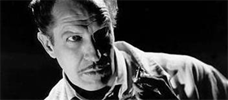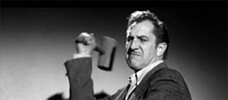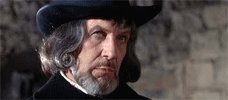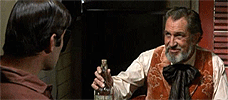Reviews
William Castle
USA, 1959
Credits
Review by Victoria Large
Posted on 21 June 2011
Source Sony Pictures VHS
Categories Vincent Price
Horror director William Castle’s name is almost synonymous with gimmickry, and his best-remembered gimmick may well be the one that accompanied The Tingler. At a selection of theaters that were screening the film back in 1959, the seats were actually wired with buzzers that gave certain audience members a slight shock at a key moment. Yet while this legendary element of the film is lost on home video viewers (as it was lost on patrons at non-wired theaters in the fifties), Castle’s audacity as a showman continues to add to The Tingler’s charm and mystique. There he is when the film opens, before the title has even come up, warning viewers that the terrifying film ahead may cause a “strange tingling sensation” in their bodies, one that can only be relieved with a scream. “A scream at the right time might save your life,” he insists, teasing us, but also giving a nod to the incredible cathartic power of a good scare (and an accompanying shriek).
Of course, it seems only fitting that Vincent Price should be on hand for a film like this. Fresh from his starring roles in The Fly and Castle’s House on Haunted Hill, Price was on his way to becoming one of horror’s most enduring icons when he appeared in The Tingler as Dr. Warren Chapin, a scientist of considerable ambition and decidedly murky morality. As an actor, Price is highly attuned to mischief that is innate in much of the best B-horror, and he’s delightfully slippery here as a work-obsessed researcher who at any minute might slide into the role of mad scientist. Chapin is the type who sends his fresh-faced researcher David into alleys looking for cats to experiment on, and screenwriter Robb White (a frequent Castle collaborator) gives him some truly brutal barbs to hurl at his openly unfaithful wife. Chapin is at best an antihero and at worst an unrepentant murderer, and Price, with his slightly askew persona, keeps us guessing.
And what is the scientific work that Chapin is so obsessed with? It’s the science of fear, naturally, and specifically a quest to discover the tangible cause of that spine-tingling feeling that humans get when they are frightened. His research leads him to discover the cutely named title creature, which lives in human spinal columns, looks like a centipede, and loses all power in the presence of screams. A sentient Tingler gets loose after Chapin performs a seemingly illegal autopsy on a deaf woman who could not speak—and therefore could not scream, literally dying of fright when overtaken by the Tingler. All of this seems as ludicrous in the film as it does when spelled out in this review, but White’s gleefully spiky dialogue, Castle’s cheerful crowd baiting, and Price’s spooky presence make the picture a glorious hoot.
The sequence in which Martha Higgins, the ill-fated deaf woman (fittingly played by Judith Evelyn, who was wordlessly memorable as Miss Lonely Hearts in Rear Window), is frightened to death, has the giddy “gotcha” quality of a carnival funhouse, complete with a machete-wielding one-armed man, a hairy arm tossing an axe, and a sink and bathtub filled to the brim with blood. That last gag is amplified by Castle’s decision to briefly break from black and white and shoot just the blood in color, splashes of unexpected red disrupting our understanding of the film itself. Indeed, The Tingler seems intent on repeatedly upending our most basic presumptions about it—it is a black and white film stained with crimson color, and a talking picture with one character, Martha, whose exaggerated movements and inability to speak make her seem like a refuge from the silent films that screen in the movie theater below her apartment.
Most notably and memorably, of course, The Tingler works overtime to keep us from dismissing it as “only a movie.” Castle’s booby-trapping of movie theaters at the time of the film’s release serves as an extreme example of a filmmaker’s attempt to bridge the divide between onscreen and off, but even without the electric shocks, the line between fantasy and reality gets a bit blurred. Toward the end of the film, when the Tingler rather inevitably runs amok in the silent movie theater and attacks the projectionist, we see the creature slide itself across an otherwise blank movie screen before we are plunged into blackness. The darkened screen is accompanied by urgent instructions delivered by Price’s Dr. Chapin: “Ladies and gentleman, please do not panic! But scream! Scream for your lives! The Tingler is loose in this theater! Scream! Scream! Keep screaming! Scream for your lives!” The moment is not only delicious in its intent at inspiring chaotic shrieking fits at movie theaters around the country (I long to see this one at a packed repertory theater rather than on video), but also fascinating in its success at collapsing the difference between its real and fictional movie theater patrons. In that respect, Price’s pronouncement that the Tingler has been paralyzed and therefore, “We will now resume the showing of the movie,” is impressive for its utter cheek.
The Tingler is remembered for how it folds its marketing gimmick into its narrative, but it’s perhaps more interesting to consider how thoroughly it is infused with the kind of heightened self-awareness and metacommentary that is almost endemic to the horror genre. Perhaps because horror films are naturally transgressive creations, they are more likely to blur and confuse cinematic boundaries. At any rate, there seems something entirely appropriate about the fact that the Tingler is at one point captured in an actual film canister, as if opening such a canister, marked with the film title that is also the creature’s name, might unleash an actual monster on the world.
More Vincent Price
-

The Tingler
1959 -

The Masque of the Red Death
1964 -

The Last Man on Earth
1964 -

The Tomb of Ligeia
1964 -

War-Gods of the Deep
1965 -

Witchfinder General
1968 -

More Dead Than Alive
1969 -

The Abominable Dr. Phibes
1971 -

Dr. Phibes Rises Again!
1972 -

Theatre of Blood
1973
We don’t do comments anymore, but you may contact us here or find us on Twitter or Facebook.



